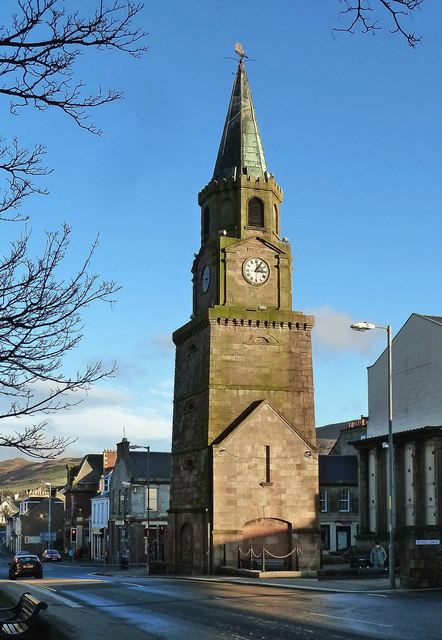 | ||
Similar Baltersan Castle, Crossraguel Abbey, Loudoun Hall, Bachelors' Club - Tarbolton, Turnberry Castle | ||
Girvan stumpy stumpy tower girvan s former jail
Stumpy Tower is a former gaol in Girvan, South Ayrshire, Scotland. It has been suggested that its popular name "Auld Stumpy" comes from the Gaelic Olladh Stiom Paidh, meaning "Great Circle of Justice". (The name of Knockcushan Street, upon which the tower sits, means "Hill [or Knoll] of Justice".) Even King Robert the Bruce has held his court in this area of Girvan, as in the 13th Century the Chief Court of the Earldom of Carrick was Girvan and one of the earliest surviving courts cases in the South West of Scotland is recorded from the Girvan Court. It was in 1260 when an investigation took place into the ownership of the lands of "Akensawelle" about 1½ miles southwest of Barr.
Contents
History
The original Stumpy, built in 1789, was a two storey thatched roof building in the former market place and had to be replaced because of the prisoners often making good their escape because of the thatched roof.
The first mention of the present day Stumpy Tower was in the town council minutes recorded on the 14th of January 1825, when it was agreed by a meeting of the Burgesses to “rebuild the two houses on the Town’s property adjoining the King’s Arms and erect, another house on the front leading to the shore, and also a Gaol and Steeple adjoining the present market house to complete the square”. Plans were submitted and approved and power given to the Magistrates and Council to borrow sufficient money to erect the whole buildings. On the 23rd of February offers for this work were submitted and the lower offer of £1,461 for the work was accepted and a contract signed.
On the 8th of July 1825 it was agreed on the recommendation of the contractors that instead of the original plan of two cells on each floor to change to one cell on each floor as there was doubts to the strength of the outer walls. Stumpy was built into a complex consisting of the Court House and Town House.
The gail was inspected on the 7th of April 1827 by the Sheriff Substitute and being fully satisfied granted a certificate stating: “The Gail is well aired and fit for the accommodation of prisoners.” It has also been noted that he was so satisfied he did this without fee or reward and was publicly thanked. After the first ten years of the gaol working in the community the Gaols Inspectorate noticed a marked decrease in crime in the town and this continued for the next 34 years of operation.
It would appear that when the gail was decommissioned the main reasons why it was left standing would primarily be the infrastructure of the complex in which it stood, the tower being 29m tall and secondly because of the Clock Tower, which provided the town with the time and there was no point in erecting another when it was fully functional.
McMaster Hall
In 1908 the Buildings around Stumpy were demolished to make way for the McMaster Hall, of which construction began in 1909 and took two year to complete, opening in August 1911.
The McMaster Hall was given to the town by John McMaster, a local banker from Kirkoswald residing in Canterbury. Among the many functions of the McMaster Hall it was primarily the Town Hall, serving purposes such as Town Council meetings but more recreationally as a Dance Hall, with rather plush toilets suspected to be underground. Sadly, in 1939 the McMaster Hall was destroyed by fire. There has been no insight into how the fire started. The only part of Stumpy that was affected by this was its steeple which, being made of copper, melted.
Stumpy today
In the mid 1950s the shell of the McMaster Hall was removed and left Stumpy to stand proudly on its own.
